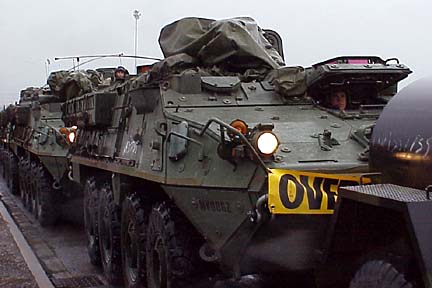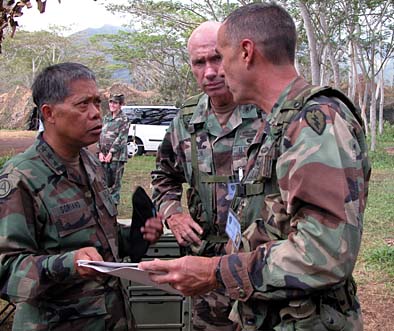
ARMY PHOTO
Stryker combat vehicles are loaded onto boats in Tacoma, Wash., for the voyage to Kuwait and Iraq. Soldiers from Fort Lewis will test the vehicles for a year.
On the move
Tests begin to determine the
combat effectiveness of Strykers
The Stryker with soldiers from Fort Lewis in Washington heads for a yearlong test in Iraq of a warfighting plan designed to replace Cold War tanks and heavy infantry.
CORRECTION
Tuesday, Nov. 4 2003>> An Army public hearing on a proposed Stryker brigade for Hawaii will be held at 7 p.m. today at the Turtle Bay Resort. An information box on Page A19 Sunday incorrectly said the hearing would be at the Makaha Resort Hotel. Also, Stryker units are intended to deploy anywhere in the world in 96 hours. An accompanying article Sunday incorrectly gave the deployment time as 196 hours.
The Honolulu Star-Bulletin strives to make its news report fair and accurate. If you have a question or comment about news coverage, call Editor Frank Bridgewater at 529-4791 or email him at fbridgewater@starbulletin.com.
Soldiers of the 3rd Brigade, 2nd Infantry Division, will begin to leave Fort Lewis this week. The brigade is the first of six designated to become the Army's first medium-weight combat fighting unit.
More Stryker hearings set
The Army last week began a series of public meetings to take testimony on its draft environmental impact statement for the Stryker brigade. The meetings will continue at 7 p.m. at:>> Makaha Resort Hotel on Tuesday.
>> Waikoloa Beach Resort on the Big Island on Wednesday.
>> Hilo Hawaiian Hotel on Thursday.
In July, Gen. John Keane, then acting Army chief of staff, said the brigade would replace the 3rd Armored Cavalry Regiment in Anbar province. Anbar is Iraq's largest province, stretching from the Jordanian, Syrian, and Saudi Arabian borders east to Baghdad. It includes the cities of Ramadi and Fallujah, scenes of frequent violent anti-coalition incidents in the heart of the "Sunni Triangle."
Among the units still waiting final approval from the Pentagon for transformation to a Stryker Brigade is the 25th Infantry Division's 2nd Brigade at Schofield Barracks.
More than $16 million has been set aside in the Army's latest budget to begin to build new training facilities for the Stryker vehicles and the more than 800 soldiers that could be in Hawaii by summer 2005. A total of 28 projects are proposed on Oahu and the Big Island, with the Army estimating that it will spend $693 million.
To accommodate the needs of the Stryker combat team, the Army has said it will acquire 23,000 acres on the Big Island and 1,400 acres adjacent to the 27,000 acres Schofield now occupies in Wahiawa.
The construction budget also allocates $65 million to the Air Force to add eight C-17 jet transports and personnel to Hickam Air Force Base to move this new Army unit. The intent is to deploy the Stryker Combat Team anywhere in the world in 196 hours, a feat still being questioned by congressional critics.
Each of the brigades hand picked by the Pentagon for the change will be equipped with the Army's newest $1.5 million, eight-wheeled 20-ton Stryker combat vehicle.
However, Lt. Gen. Edward Soriano, the commander of 22,000 soldiers at Fort Lewis and I Corps, emphasized recently that the change is not just about a vehicle.
GREGG K. KAKESAKO / GKAKESAKO@STARBULLETIN.COM
Lt. Gen. Edward Soriano, left, confers with Maj. Gen. Eric Olson, 25th Division commanding general, and Lt. Col. Stephen Christian, commander of the 1st Battalion, 62nd Regiment, at Schofield Barracks during a recent training exercise. Soriano commands I Corps and Fort Lewis, where the first Stryker combat brigade has trained for the past three years.
"It's about a combat system," said Soriano, 56, who spent a week at Schofield Barracks last month participating in a three-week war game simulation.
"The Stryker by itself won't do it," said Soriano, who assumed command at Fort Lewis more than a year ago. "In the long run, it's about a system and it's about the soldiers who come out of the back of those vehicles.
"It's about a system, which, through the use of a secured Internet connection and satellites, will link anti-tank, artillery, intelligence and infantry units together."
Soriano, the Army's highest ranking officer of Filipino-American ancestry, said the Stryker was never intended to be a fighting vehicle, like the heavier M-1A1 Abrams tank or Bradley fighting vehicle. "It was never meant to be a vehicle designed for a fight-on-fight, but merely to take soldiers to the battlefield."
Unlike past military doctrine, which was designed around using heavy armored tanks and infantry brigades to make contact with the enemy, Soriano said the idea now is "to find where the enemy is before we take them on ... to see the enemy at a distance before we engage."
Each of the Stryker Combat Teams will be equipped with 310 eight-wheeled armored vehicles that can be outfitted in nine different ways with everything from 105 mm cannons to medical supplies as a battlefield ambulance to command and intelligence centers. It is supposed to be operational even when four of its wheels have been shot out.
As a reconnaissance, surveillance and target acquisition vehicle, the Stryker can be equipped with a Shadow unmanned aircraft -- a drone -- as well as electronic intelligence systems and portable anti-missiles.
As a troop carrier, these combat vehicles -- the first the Army has produced in 20 years -- can travel up to 60 mph and can carry 11 soldiers.
Soriano believes the Army has worked out past criticism that the Stryker was too heavy or too large to fit into Air Force jet transports or lacked the protective armor against rocket propelled grenades -- the weapon of choice of Iraqi guerrilla fighters. A protective cage, resembling a big catcher's mask, has been built around the vehicles. The armor is basically a grill of wire mesh that will cause the grenades to detonate away from the vehicle. The Army also has installed ceramic tiles on the vehicles to give them the ability to stop heavy machine gun rounds.
The three-star Army general said Strykers have been deployed from Fort Lewis on C-130, C-17 and C-5 Air Force cargo planes to places like Fort Polk, Fort Irwin and South Korea.

